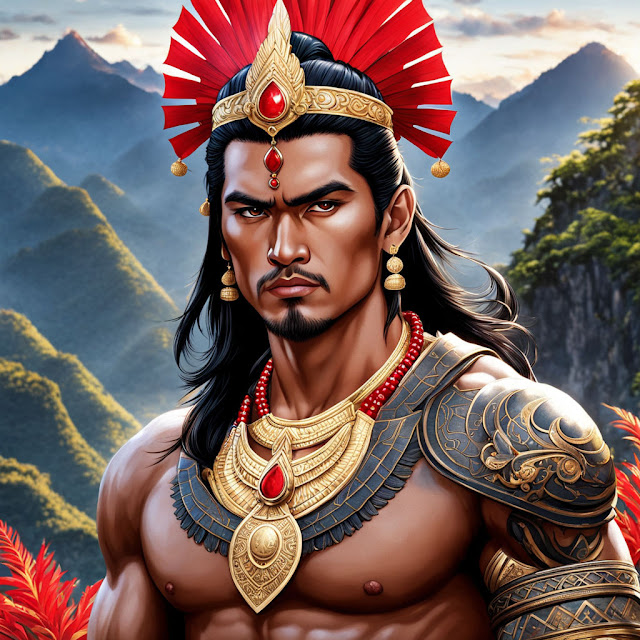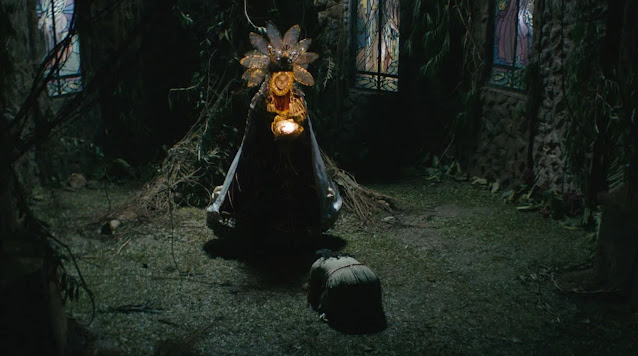.jpeg) |
| Diwata at mga Lambana |
 |
| Diwata |
Diwata
Ang mga Diwata ay mga mabait at mapag-arugang espiritu,nagkakatawang magandang nilalang nagbibigay ng biyaya at magandang kapalaran sa mga taong nagbibigay-pugay sa kalikasan. Pinangangalagaan nila ang mga kagubatan, ilog, bundok, at iba pang likas na tanawin, tinitiyak na nananatiling balanse ang kapaligiran. Ang mga taong nagpapakita ng respeto at pagmamahal sa kalikasan ay maaaring makatanggap ng kanilang pabor, ngunit yaong mga sumisira sa kapaligiran ay maaaring magdanas ng kanilang galit.
 |
| Diwata at mga lambana |
Diwata in Philippine mythology and Modern context
In contemporary Philippine language and mythology, the term Diwata is a gender-neutral umbrella term referring to fairies, gods, goddesses, nature spirits, nymphs, and fairies. It is often associated with small winged fairies known as Lambana.
Diwata and Anito
The modern Filipino understanding of diwata encompasses meanings such as muse, fairy, nymph, dryad,or even deity (god or goddess). The word is thought to originate from the Sanskrit devata (deity). Similarly, the term Anito—widely understood today as referring to ancestor spirits or spirits of the dead—may have derived from the proto-Malayo-Polynesian qanitu and proto-Austronesian qanicu, both of which mean ancestral spirits.
 |
| Diwata at Anito |
 |
| Diwata |
Bilang mga tagapagbantay, ang Diwata ay sumisimbolo sa malalim na koneksyon ng mga tao sa kalikasan, nagsisilbing paalala ng kahalagahan ng pangangalaga at paggalang sa kapaligiran.
Sa mitolohiyang Filipino ayon sa mga Filipino sa Pilipinas
Diwata sa mitholohiya bilang pangkalahatang tawag sa sumusonod:
Supreme deity - Bathala, Diwata ng mga diwata, Anito ng mga anito (Bathalang Maykapal, Gugurang, Laon )
High Sky Gods - Diwata ng kaitaasan, matataas na diwata o mga bathala
Nature Spirits and Minor Gods - Diwata ng ibabawnun, , mga bathala sa lupa
Dryads, High fairies, Nymphs and Minor gods - Mga Diwata, Diwata ng kalikasan, mga ada, mga lambino
 |
| Diwata |
Philippine Fairies and Lambana - Diwata at lambana (winged-fairies)
 |
| Lambana |
Diwata
 |
| Diwata |
Diwata at Lambana
Ang pinakatanyag na Diwata, na madalas napagkakamalang o tinatawag na isang Lambana, ay si Maria Makiling.
.jpeg) |
| Lambana |
Sa mitolohiyang Pilipino, ang mga Lambana ay maliliit na pakpakang diwata na may kakayahang magbago ng anyo upang magmukhang tao. Sila’y kadalasang nagsisilbing mga katulong o mensahero ng mas makapangyarihang mga nilalang na kilala bilang Diwata, na mga espiritu ng kalikasan o mga diyos ng kalangitan. Kung ang isang Diwata ay masama, ang Lambana na naglilingkod dito ay nagiging masama rin, sumasalamin sa ugali ng kanilang panginoon. Bagama’t konektado sila sa mahiwagang kapangyarihan ng kalikasan, kaya rin ng mga Lambana na makisalamuha sa mga tao nang hindi nawawala ang kanilang mahiwagang esensya.
 |
| Lambana |
Ang mga Diwata at Lambana ay partikular na kilala sa mga alamat ng mga Tagalog at Bicolano, lalo na sa rehiyon ng Luzon.
Pagpapatuloy ng Mga Kuwento ng Diwata at Lambana
Sa kasalukuyan, ang mga kuwento at alamat tungkol sa mga Diwata at Lambana ay patuloy na isinasalaysay at muling isinasalaysay ng mga Pilipino. Isang patunay ng kapangyarihan ng pasalitang mitolohiyang Pilipino.
 |
| Diwata |
 |
| Diwata |
 |
| Diwata in Philippine mythology |
.jpeg) |
| diwata |
.jpeg) |
| Diwata |
 |
| diwata |
In Philippine mythology, Diwata is a broad and fluid term used to refer to various divine and spiritual beings. These beings range from supreme deities to nature spirits and mystical creatures. Here's a breakdown of the different kinds of Diwata:
Supreme Deity (Bathala, Gugurang, Laon)
- Bathala – The supreme deity of the Tagalog people, known as the "creator of everything" "Diwata of all Diwata."
- Gugurang – In Bicolano mythology, the supreme god who rules over good and controls the fire of Mayon Volcano.
- Laon – The supreme deity in Visayan mythology, known as the great creator and ruler.
These deities are considered the highest in the hierarchy, often referred to as "Diwata ng mga Diwata" or "Anito ng mga Anito" (god of gods), holding power over creation, life, and death.
High Sky Gods (Matataas na Diwata o Bathala)
- Idianale – Goddess of agriculture and good labor.
- Inagined - Visayan Goddess of War and poisons
- Amanikable – God of the sea, fishing and the waves.
- Tala – The goddess of the stars and night sky.
- Mayari – The goddess of the moon, beauty, and war.
- Bulan - The god of the Moon, waters and night
- Apung Malyari – The Kapampangan god of strength and power, associated with Mt. Arayat.
These are the "Diwata ng Kaitaasan" (gods of the sky), often associated with the heavens, celestial bodies, and the natural elements like the sun, moon, and stars. Celestials and beings of Skyworld
Nature Spirits and Minor Gods (Diwata ng Ibabawnun)
 |
| Linti diwata ng kidlat |
- Ibabawnon – The Visayan term for the upper world, where minor deities and nature spirits reside.
- Lakambakod – The god of protector fences and boundaries, often invoked for protection.
- Linti - Bicolano lightning god and protection
- Lalahon – The goddess of volcanoes, fire, and agriculture.
- Anitun Tawu– goddess of wind
These Diwata ng Ibabawnon are spirits or minor gods associated with specific aspects of nature or human life, such as agriculture, the sea, or protection. or those who have descended to mortal lands
Dryads, High Fairies, and Nymphs (Diwata ng Kalikasan, Mga Ada)
- Maria Makiling – The guardian of Mount Makiling, known for her ageless beauty and connection to the forest.
- Maria Sinukuan – The diwata of Mount Arayat, associated with bountiful harvests and nature.
- Maria Cacao – The guardian of Mount Lantoy, associated with the cacao plant and rivers.
These Diwata ng Kalikasan (nature spirits, high fairies and goddesses) are often depicted as guardians of specific natural landscapes like mountains, forests, rivers, and fields. They are also known as Ada, fairy-like beings who protect nature and bestow blessings or punishments based on how humans treat the environment.
Philippine Fairies and Lambana (Diwata at Lambana)
 |
| Lambana |
 |
| Diwata at mga Lambana |
Specific and generic terms for Diwata as fairies
- (Diwata) Lambana – Winged fairies, often smaller in stature than Diwata but equally magical. They serve as helpers or messengers of greater beings and are often mischievous or benevolent.
- 8Diwata) Engkantada – Fairies or nature spirits who dwell in hidden realms or enchanted forests, capable of blessing or cursing mortals.
- (Diwata)Engkantado - Fairy,Tagalog-Spanish archaic term for male fairies
These fairies are "Diwata ng Kalikasan" with more ethereal, magical qualities. They include both high-ranking fairies and lesser winged beings such as the Lambana.
.jpeg) |
| Male Diwata is sometimes called Lambino |
 |
| Lambana |
 |
| Diwata |
Overview of Diwata as an Umbrella Term
Philippine Mythology
- Supreme Deities – Bathala, Gugurang, Laon (creators and rulers).
- High Sky Gods – Idianale, Amanikable, Mayari (sky and celestial deities).
- Nature Spirits and Minor Gods – Lakambakod, Lalahon (guardians of the natural world).
- Dryads, High Fairies, Nymphs, gods – Maria Makiling, Maria Sinukuan, Diwata, Ada, Lambino (protectors of specific natural sites).
- Philippine Fairies and Lambana – Diwata, Lambana, Engkantada (small, winged fairies and elemental beings).
 |
| Diwata |
 |
| Diwata |
The term Diwata in MYTHOLOGY thus an inclusive, overarching title used for many kinds of spiritual beings in the Philippines, embodying everything from powerful deities to benevolent fairies and nymphs. These entities represent the deep connection between the Filipino people, nature, and the spirit world, reflecting both the country's rich pre-colonial spiritual heritage and its continued relevance in contemporary times.
Orally transmitted stories undergo variations and evolve over time, resulting in numerous different versions. There are many different version told by Filipinos, and retold by Filipinos.
The orally transmitted mythology of the Philippines is intended for sharing and understanding. It is a dynamic narrative tradition that evolves over time, distinct from the standardized mythologies found in Western and European cultures. Unlike these established mythologies, the Philippine government has not mandated standardized versions of stories and legends.
Orally transmitted stories undergo variations and evolve over time, resulting in numerous different versions. There are many different version told by Filipinos, and retold by Filipinos.
Mga kwentong Pilipino at pagkukwento ay para sa lahat...
Philippine Mythology is for everyone—Filipinos, Filipinxs, and even foreigners! These stories are meant to be shared, enjoyed, and passed down through generations. They’re not set in stone and can have many different versions You don’t have to be an expert to enjoy them. These stories evolve with time, and everyone is welcome to listen, share, and get lost in their world. Mythology connects us all, no matter where we come from!

















.jpeg)




.jpeg)
.jpeg)








.jpeg)
.jpeg)
.jpeg)
.jpeg)











.jpeg)
No comments:
Post a Comment
Note: Only a member of this blog may post a comment.